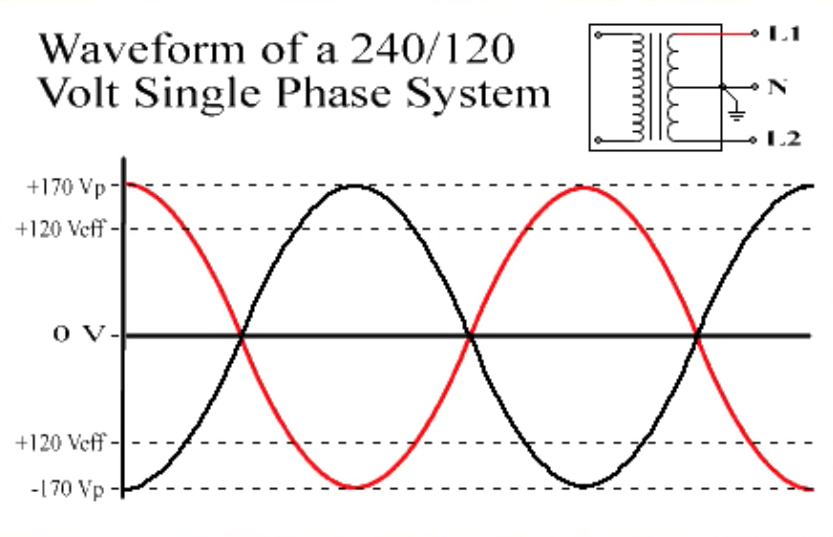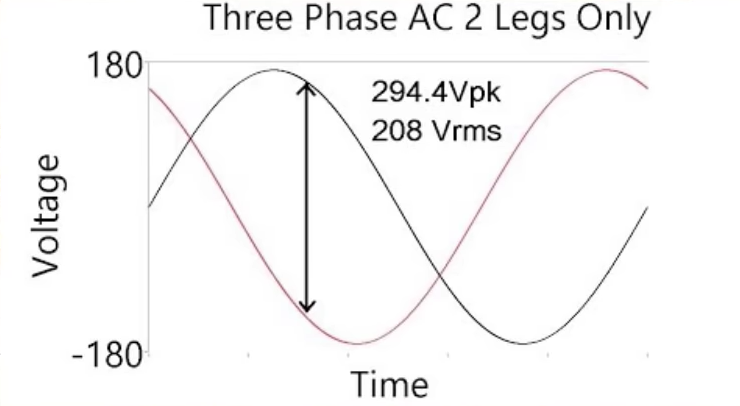How To Tell If Electric Service Is 240v Or 208v

The like shooting fish in a barrel answer is 32v. Form dismissed.
I'g simply joking, of course. Finding the divergence betwixt 208 and 240v ability supplies may sound quite unproblematic, but at that place are some pretty sharp key differences.
Apart from the obvious differences in overall voltage, 208 and 240v power supplies use the electric company's power differently. The motors as well see entirely different sine waveforms. The potential beyond these waveforms varies, which is where nosotros become the unlike voltages from. We too tend to utilize 240v power in residential applications, while we use 208v in light commercial applications.
This article volition go over the differences between unmarried or split up-phase 240v motors and 208v ones. It volition also talk over the applications of each power source blazon and why it may not exist a adept idea to utilise 208v motors for 240v applications.
Visualizing voltage
Before we swoop into the differences betwixt voltage types, we should probably talk nearly how we visualize voltage and how it relates to motor movement.
Equally you know, electric motors rotate in a circular motion. We don't view the corresponding voltage as a circle, though. We visualize and map voltage patterns as sines, which are wavy lines that rise and fall at a regular charge per unit on a chart.
A sine wave takes the rotation of a circumvolve (in degrees) and compares it to unit time. Look at the picture below.

Every bit you can see, the sine moving ridge "rolls out" the circle by plotting the changes in its degrees equally time progresses. When the motor rotates thirty° from a starting point of 0°, you can run into that rise on the sinusoidal waveform. The sine wave peaks at 90°, as that's the highest point on the rotation. Information technology also bottoms out at 270°, which is the everyman indicate. You can run into all of those on the left circumvolve.
Each ability leg has its own sinusoidal waveform, and that'south where you lot will see the differences betwixt 240v single-phase motors and 208v motors.
240v single-phase and split-stage
We sometimes use the terms single-phase and split-phase interchangeably, and information technology tin can be confusing. Although they roughly mean the same thing, they sound contradictory, so we'll explain the names.
"Phase" refers to the use of the original power from the utility. The power visitor offers 3 legs of power, and then a unmarried-phase organisation simply derives its power from one of those legs.
We also refer to single-phase power as split-phase power considering the single-phase power can split into two carve up, opposing phases. If you look at a waveform, you'll notice iii lines: two contrary sines and 1 apartment line. The apartment line is the center tap, and the sines are the dissever phases.
The split up phases are 180° straight out of stage and e'er have directly opposing values. If you recollect about our before circle, 90° and 270° are 180° apart from each other, and they are the top and trough of the wave, respectively. Therefore, when one of those carve up phases reaches its highest indicate, the other phase will lesser out. However, they cross once they reach the zip signal (on the center tap). That's because 0° and 180° are on the aforementioned horizontal line in a circle. You can see all of this in action below.

Single- and split up-phase motors are commonly 240v or 230v. Some split up-phase power sources may be 220v, 120v, 115v, then on, but higher-voltage applications are more than common nowadays. You'll probably run across 240v the nearly ofttimes, but y'all may encounter some even college voltages, like 245v or 246v.
So, where does the 208v come in?
Equally yous could probably assume, power sources with 208 volts are NOT really single-phase. They require two legs of power from the power utility, whereas 240v motors and appliances merely use i.
Y'all will commonly see 208v present in three-phase buildings when "unmarried-phase" equipment (like an A/C condenser) is wired to ii legs of three-phase wye power.
Hither's where some people get dislocated: if a split-phase motor splits a single power source into ii 120v phases, then shouldn't a motor that uses two legs of 3-phase ability also equal 240v?
No, and here'southward why:
Recall when I said that the sine waves of separate-phase motors are 180° out of stage? The power legs of 208v motors are actually 120° out of stage. The distance between the sine waves isn't totally opposite. They can't reach their full potential if they don't direct oppose each other, and the voltage is lower overall every bit a result.
Yous can especially see this when you expect at a graph. The sine waves look more like they wind around each other, non cross over a fixed center signal. The maximum potential between the points is lower overall. You can meet this in the epitome below.

Can you lot utilise 208v motors instead of 230v/240v?
You may notice that some unmarried-phase motors are rated for 208/230v. So, it may seem like the motor will find means to make up for the lower voltage. That'due south not quite how these motors work. Yous'll meet some differences in performance if y'all employ a 230v motor for a 208v awarding, even if information technology's rated for both.
You can't expect the same degree of performance when you utilise 208v on 230v (or higher) applications. For example, when y'all use a 208v motor in a residential condensing unit that typically requires 230v, the unit won't run at its full chapters.
Some people say that you tin await a higher electric current when you lot utilise 208v in place of 230v, but that'due south quite rare. The motors don't magically make upward in electric current what is lost in voltage, even if it might brand sense to see higher electric current from the rated watts or horsepower. Instead, when a typical 208/230v motor is connected to 208v, it usually slips more and runs at a lower output than on 230v or 240v. That results in lower wattage used at a lower efficiency, which adds up to few BTUs produced.
208/230v motors also have a harder time starting upward, and they may produce a problematic voltage drop more ofttimes when connected to 208v. Voltage drop usually isn't an upshot for split-phase 240v systems. Notwithstanding, on 208v, the motors kickoff with a lower voltage. Therefore, the same amount of driblet will have a greater result on the organisation.
In short, simply because a 208v motor may be designed to run on 230v or 240v systems by using two ability legs from the utility source, that doesn't mean that it will provide the same output efficiency. Yous will see differences in performance if you endeavor to use 208v when 240v is typically required.
How To Tell If Electric Service Is 240v Or 208v,
Source: https://hvacrschool.com/whats-the-difference-between-208v-and-240v/
Posted by: bondyoultold.blogspot.com


0 Response to "How To Tell If Electric Service Is 240v Or 208v"
Post a Comment